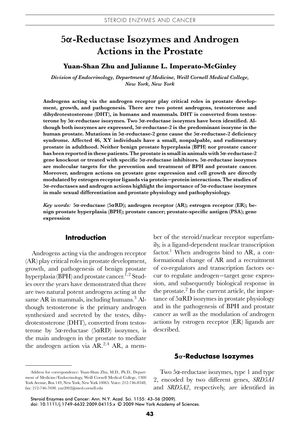TLDR 5α‐reductase isozymes are crucial for prostate development and health, and targeting them can help prevent and treat prostate issues.
Androgens, particularly testosterone and dihydrotestosterone (DHT), played crucial roles in prostate development and pathology, with DHT being converted from testosterone by 5α‐reductase isozymes. Two isozymes were identified, with 5α‐reductase‐2 being predominant in the human prostate. Mutations in the 5α‐reductase‐2 gene caused a deficiency syndrome, leading to a small, rudimentary prostate in affected individuals, who did not develop benign prostate hyperplasia (BPH) or prostate cancer. Animal studies with 5α‐reductase‐2 gene knockout or specific inhibitors also showed reduced prostate size. These isozymes were key targets for preventing and treating BPH and prostate cancer, and androgen actions on prostate gene expression and growth were modulated by estrogen receptor ligands. The research underscored the significance of 5α‐reductase isozymes in male sexual differentiation and prostate health.
 67 citations
,
February 1997 in “Teratology”
67 citations
,
February 1997 in “Teratology” Finasteride, when given in high oral doses to pregnant monkeys, caused genital abnormalities in male fetuses, but not in female fetuses or those exposed to intravenous finasteride.
 1040 citations
,
October 1992 in “The New England Journal of Medicine”
1040 citations
,
October 1992 in “The New England Journal of Medicine” Finasteride effectively treats BPH but may increase sexual dysfunction risk.
 76 citations
,
September 1992 in “Endocrinology”
76 citations
,
September 1992 in “Endocrinology” The human type II 5α-reductase gene has a specific structure important for understanding certain medical conditions.
 143 citations
,
August 1991 in “Endocrinology”
143 citations
,
August 1991 in “Endocrinology” Androgens, like testosterone, are crucial for early testicular descent in rats.
 June 2023 in “Clinica Chimica Acta”
June 2023 in “Clinica Chimica Acta” Finasteride and dutasteride effectively reduce DHT in hair, which may help evaluate their treatment success for hair loss.
 215 citations
,
November 2006 in “Journal of The American Academy of Dermatology”
215 citations
,
November 2006 in “Journal of The American Academy of Dermatology” Dutasteride more effective for hair growth, but has more side effects than finasteride.
 65 citations
,
October 1999 in “Journal of The American Academy of Dermatology”
65 citations
,
October 1999 in “Journal of The American Academy of Dermatology” Finasteride effectively reduces hair loss by decreasing androgen levels.
 59 citations
,
September 1994 in “The Journal of Clinical Endocrinology and Metabolism”
59 citations
,
September 1994 in “The Journal of Clinical Endocrinology and Metabolism” Finasteride reduces scalp DHT levels, potentially treating male pattern baldness.
 124 citations
,
January 1993 in “The Prostate”
124 citations
,
January 1993 in “The Prostate” Finasteride effectively inhibits 5α reductase, while plant extracts like Permixon and Bazoton don't show significant results.










